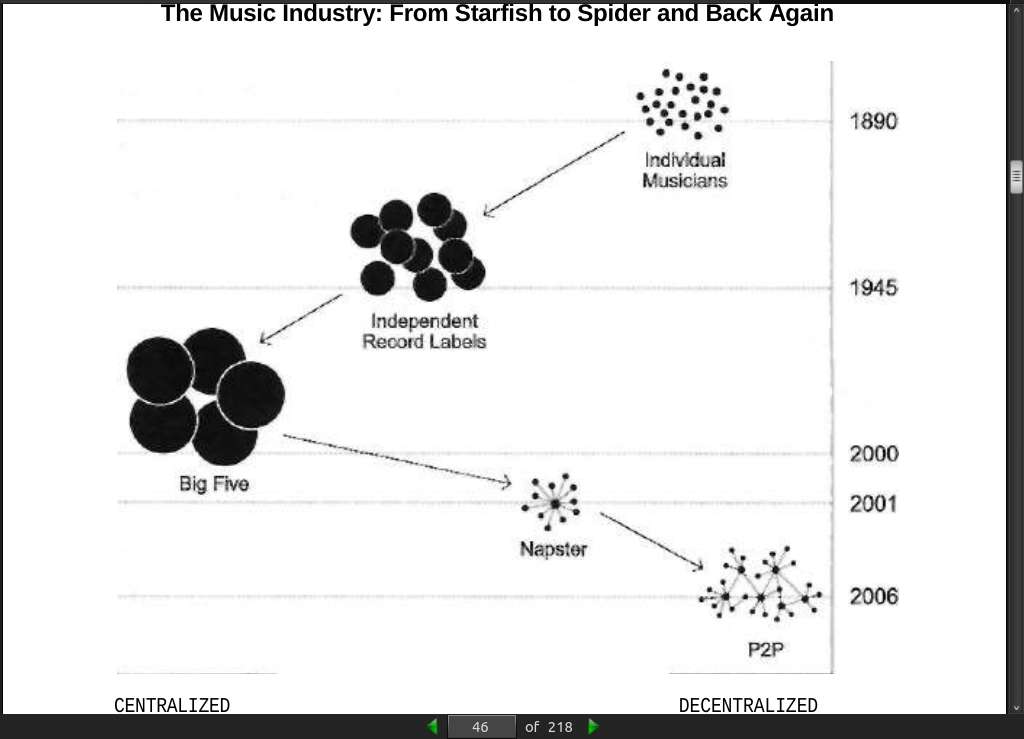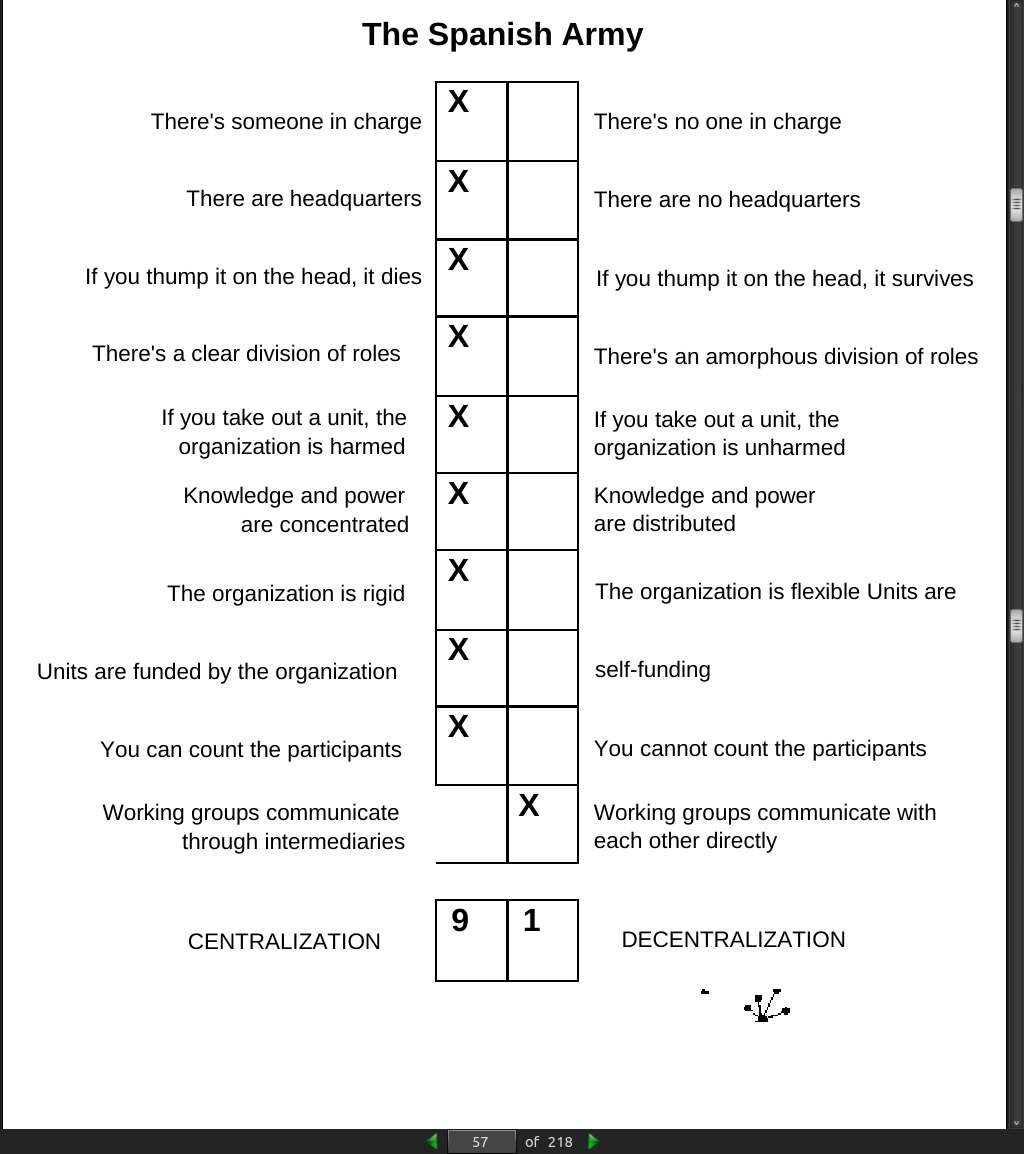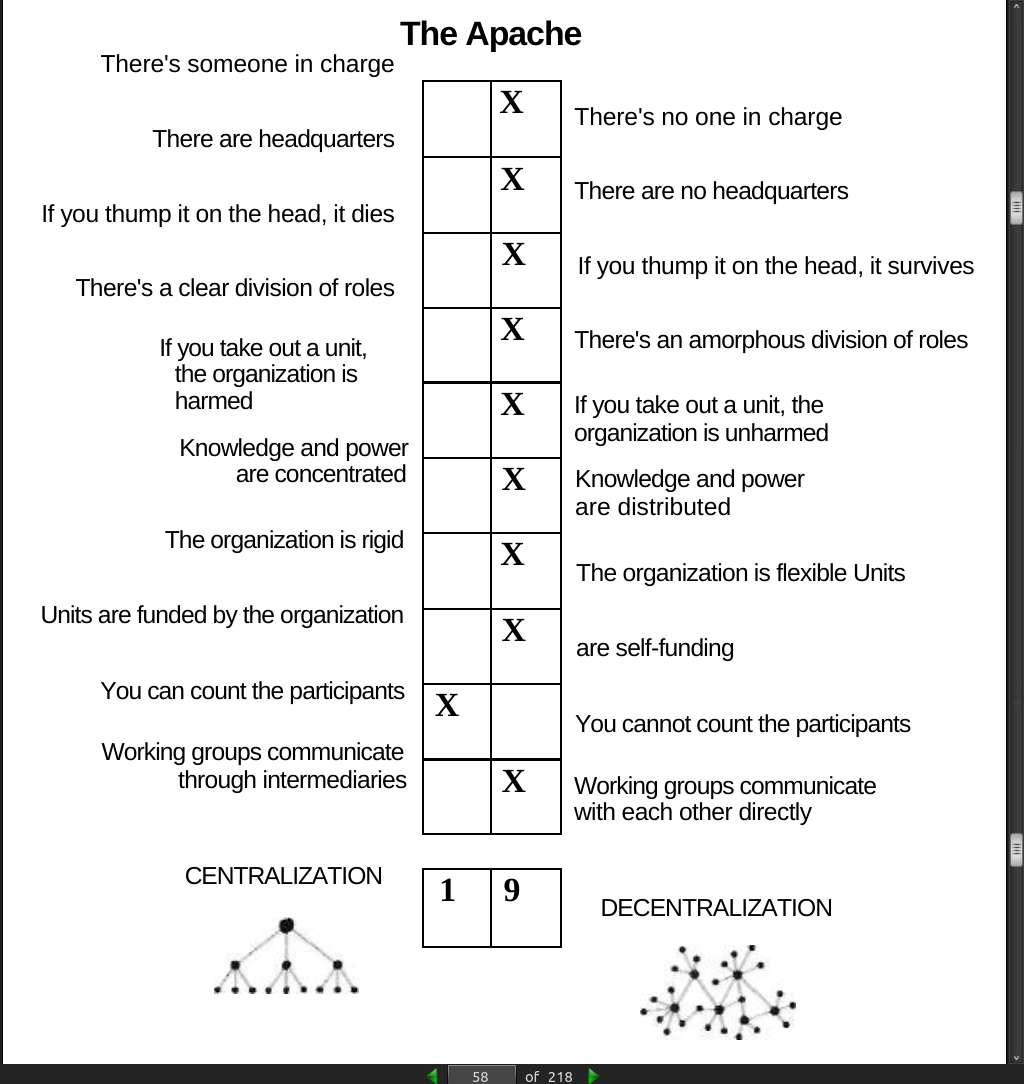Home · Book Reports · 2017 · The Starfish and the Spider - The Unstoppable Power of Leaderless Organizations

- Author :: Ori Brafman and Rod A. Beckstrom
- Publication Year :: 2006
- Read Date :: 2017-08-31
- Source :: starfish_and_the_spider.pdf
designates my notes. / designates important.
Thoughts
My first thoughts upon finishing this book were that it is eerily familiar to the plans for decentralizing the English empire into a commonwealth.
I heard Bill Clinton promoting this book a few years ago. This piqued my interest in wondering if this would be a disinformation book or a glimpse into the oligarchy’s thought structure. I can safely say that, while there may be disinformation contained within, the book reveals, in laymen terms and with great ease in reading, the idea behind many of the new control mechanisms we see around us today. The network effect has been understood since the advent of graph theory, but in the post World War 2 environment it seems to have been harnessed for social control in earnest. This book offers an introductory perspective on what the oligarchy has known for decades.
Pierre Omidyar, of eBay/Paypal fame, both lauds this book and is interviewed within its pages. eBay, along with Craigslist, are two of the main examples of decentralized, or at least partially decentralized, organizations born of the internet. Recited ad infinitum is the buzzword “community”. The community of eBayers or Craigslisters or Amazon book reviewers are trotted out as the future of interaction and trust. Given that the book was published in 2006, I’d say it did accurately predict how these so-called communities would be at the center of our connected world.
One of the communities I was only half surprised to see discussed was that of Burning Man. Steve Outrim, of Burners.me, has shown a plethora of evidence that Burning Man is essentially the peak of modern psychological warfare and culture creation. Steve has put together a very good presentation on Gnostic Media. Burning Man is the epitome of pushing depravity into culture in the form of promiscuous sex, drugs, homosexuality, and even pedophilia. It primarily targets disenfranchised youth with the allure of raver culture and pries said youth away from traditional families by having them reassociate the BM community as their new family.
Another interesting phrase you’ll find in the book is “agents of change”. Reading that had all my alarm bells sounding. That is very “Cultural Patterns and Technical Change”-ish. Refering back to the claim that Burning Man is an experiment in culture creation, plus the changes anyone can see all around the world for the last few decades and accelerating currently, you can see why “agents of change” in addition to the suggestion that starfish organizations must be fought by altering their underlying ideology could be interesting to the people in Bill Clinton’s community.
The last chapter is quite in you face with the title: “The New World”.
Additionally, Al Qaeda is used as an example of a decentralized network. If you subscribe to the thought that AQ might be some kind of Operation Gladio B, and they are using the same ideologically driven strategy that only gets stronger when confronted by traditional means… doesn’t it follow that the people behind AQ/Gladio B knew that this operation would increase in potency when those same people are behind the traditional tactics we have seen in the Middle East for almost 20 years?
It is so easy to read it feels like it could be titled: “How to Structure the New World Order for Dummies”
page 19:
- Compare Apache (tribe) to Napster.
page 24:
- In a decentralized organization, there’s no clear leader, no hierarchy, and no headquarters. If and when a leader does emerge, that person has little power over others. The best that person can do to influence people is to lead by example.
page 25:
- …the first major principle of decentralization: when attacked, a decentralized organization tends to become even more open and decentralized.
page 29:

page 36:
- …common human trait: when we’re used to seeing something in a certain way, it’s hard to imagine it being any other way. If we’re used to seeing the world through a centralized lens, decentralized organizations don’t make much sense.
page 41:
-
It’s not that open systems necessarily make better decisions. It’s just that they’re able to respond more quickly because each member has access to knowledge and the ability to make direct use of it.
-
This brings us to the third principle of decentralization: an open system doesn’t have central intelligence; the intelligence is spread throughout the system. Information and knowledge naturally filter in at the edges, closer to where the action is.
page 42:
- The fourth principle of decentralization is that open systems can easily mutate.
page 43:
- fifth principle of decentralization: the decentralized organization sneaks up on you. Because the decentralized organization mutates so quickly, it can also grow incredibly quickly.
page 46:

page 47:
- sixth principle of decentralization: as industries become decentralized, overall profits decrease. Introduce starfish into the equation and wave good-bye to high profits.
page 50:
- A department is a leg of the spider.
page 53:
- Because they are autonomous, the units of a decentralized organization are almost always self-funding.
page 55:
- In open systems, on the other hand, communication occurs directly between members.
page 57:

page 58:

page 75:
- seventh principle of decentralization: put people into an open system and they’ll automatically want to contribute.
page 78:
- The Burning Man festival, which happens yearly in the Nevada desert, is known for eclectic costumes, rave music, and a host of naked people on Ecstasy and pot. It’s also the only 24/7 decentralized experience you can find these days.
page 85:
- When [slavery] abolitionists organized sugar boycotts, the industry warned people that not eating sugar was bad for your teeth.
page 88:
- when circles take on more than fourteen or so members, the bond breaks down. Members become more anonymous, and that opens the door to free-riding or destructive behavior.
page 94:
- Ideology is the glue that holds decentralized organizations together.
page 117:
- Instead of looking for a list of people to fund raise from, catalysts look for a list that can fund raise for. Instead of asking for donations, they ask for people to advocate for the cause.
page 121:
- Once there’s an emotional connection, then and only then is it time to brainstorm and talk strategy.
page 123:
- when left to their own devices, members of a starfish organization can become frustrated with the catalyst. “What are we supposed to be doing?” they may ask. But it’s precisely this question that leads people to take charge, giving members a high level of ownership over the organization.
page 125:

page 126:
- Catalysts are bound to rock the boat. They are much better at being agents of change than guardians of tradition.
page 135:
-
The Founding Fathers realized the importance of power distribution. The Constitution is therefore based on two key starfish principles. First, the government is divided into three branches, each of which is fairly autonomous and independent. Second, the Constitution purposely keeps the federal government weak, delegating significant power to the states.
-
Over the years, the federal government gradually became larger and more centralized. Centralization did have its advantages— the government established programs like a central banking system and currency, welfare to help the poor, the Environmental Protection Agency (EPA) to conserve resources, and Social Security for the elderly. The move toward centralization was gradual. The events of September 11, 2001, however, greatly accelerated this process.
page 137:
- the only part of the decentralized organization that you can realistically go after is the ideology.
page 142:
- But changing ideology isn’t easy. As social psychologists know, it takes at least a month of concerted persuasion to change someone’s ideology. Simply put, we don’t change our worldviews overnight.
page 145:
-
Here’s what broke Apache society: the Americans gave the Nant’ans cattle. It was that simple. Once the Nant’ans had possession of a scarce resource—cows—their power shifted from symbolic to material. Where previously, the Nant’ans had led by example, now they could reward and punish tribe members by giving and withholding this resource.
-
Replace cows with cash and you see how society in general has been broken.
page 147:
-
Once people gain a right to property, be it cows or book royalties, they quickly seek out a centralized system to protect their interests. It’s why we want our banks to be centralized. We want control, we want structure, we want reporting when it comes to our money.
-
The moment you introduce property rights into the equation, everything changes: the starfish organization turns into a spider. If you really want to centralize an organization, hand property rights to the catalyst and tell him to distribute resources as he sees fit.
-
if Burning Man introduced VIP tickets that gave people access to better campsites and line-cutting privileges, participants would no longer be equals.
-
Prophetic…
page 148:
- if you can’t beat them, join them. The best opponent for a starfish organization is often another starfish.
page 158:
- the “network effect.” Say there’s only one telephone in the world. It’s not going to be worth much, right? After all, who are you going to call? But when there are two telephones, their value goes up dramatically. Each additional telephone adds value to the overall phone system.
page 178:
- Drucker then got philosophical: “The Confucian concept, which the West shares, assumes that the purpose of learning is to qualify oneself for a new, different, and bigger job … within a certain period of time the student reaches a plateau of proficiency, where he then stays forever. The Japanese concept may be called the ‘Zen approach.’ The purpose of learning is self-improvement. It qualifies a man to do his present task with continually wider vision, continually increasing competence, and continually rising demands on himself.”
page 191:
-
there are new rules to the game.
-
RULE 1: Diseconomies of Scale
-
RULE 2: The Network Effect
-
RULE 3: The Power of Chaos
-
RULE 4: Knowledge at the Edge
-
RULE 5: Everyone Wants to Contribute
-
RULE 6: Beware the Hydra Response Decentralized orgs will multiply if you attack them, like cutting up a starfish.
-
RULE 7: Catalysts Rule
-
RULE 8: The Values Are the Organization
-
RULE 9: Measure, Monitor, and Manage
-
RULE 10: Flatten or Be Flattened